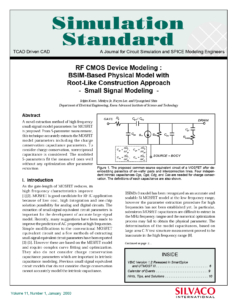RF CMOS Device Modeling: BSIM-Based Physical Model with Root-Like Construction Approach&Small Signal Modeling
Department of Electrical Engineering, Korea Advanced Institute of Science and Technology
Abstract
A novel extraction method of high frequency small-signal model parameters for MOSFET is proposed. From S-parameter measurement, this technique accurately extracts the MOSFET model parameters including the charge conservation capacitance parameters. To consider charge conservation, nonreciprocal capacitance is considered. The modeled S-parameters fit the measured ones well without any optimization after parameter extraction.
I. Introduction
As the gate-length of MOSFET reduces, its high frequency characteristics improve [1][2]. MOSFET is good candidate for RF IC application because of low cost, high integration and one-chip solution possibility for analog and digital circuits. The extraction of small-signal equivalent circuit parameters is important for the development of accurate large signal model. Recently, many suggestions have been made to improve the prediction of AC properties at high frequencies. Simple modifications to the conventional MOSFET equivalent circuit and a few methods of extracting small-signal equivalent circuit parameters have been reported [3]-[5]. However these are based on the MESFET model and require complex curve fitting and optimization. They also do not consider charge conservation capacitance parameters which are important in intrinsic capacitance modeling. Previous small-signal equivalent circuit models that do not consider charge conservation cannot accurately model the intrinsic capacitance.
BSIM3v3 model has been recognized as an accurate and scalable Si MOSFET model at the low frequency range, however the parameter extraction procedure for high frequencies has not been established yet. In particular, submicron MOSFET capacitances are difficult to extract in the MHz frequency rangne and the numerical optimization process may fail to obtain the physical parameter. The determination of the model capacitances, based on large area C-V test structure measurement proved to be inaccurate in the high frequency range [8].



